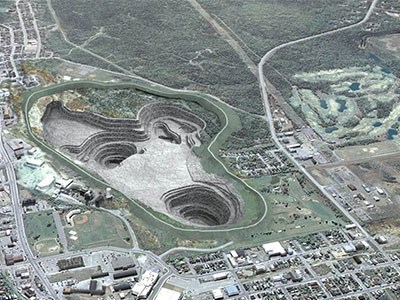Porcupine Gold Mines (PGM) has received its final environmental approval from the province, paving the way for work to start on its Hollinger open pit mine.
The environmental compliance approval (ECA) focused on noise, vibration and dust associated with the project, and was awarded by the Ministry of the Environment in early December.
Located adjacent to Timmins’ downtown core, the Hollinger site involves the repurposing of an historic underground mine, which operated for close to 60 years before closing in 1968. PGM, a subsidiary of Goldcorp, has spent $8 million to fill subsidences and other hazards that remain on the property.
The new project proposes eliminating the remaining hazards by removing the land around them and creating one large opening. The openpit operation will recover the gold remaining underground over an eight-year mine life. Ore will be processed at the company’s mill located at its nearby Dome Mine.
Planning for the project has been ongoing since about 2006, but work on the site has got off to a sluggish start.
“We’re just starting slowly,” said Marc Lauzier, PGM’s general manager. “It’s just a little slower getting started and obviously getting a permit just before Christmas complicates things a little bit.”
The stripping of overburden began in December as the company readied for blasting and road construction in the new year.
Work was set to start immediately on a berm surrounding the pit, designed to control noise, dust and vibration. Mining is set to start in 2014, as construction on the berm continues, but at a moderate pace and only during the day to start.
“So the first year, there’s mining and blasting going on, but I’d say it’s at a reduced rate and it’s only on day shift in order for us to get the berm completed and get us set up so we can properly do things and have a low impact on the community, especially at nighttime when people are sleeping,” Lauzier said. Though the project looks different now than it did in Porcupine’s original proposal, it’s not entirely accurate to say the scope of the project has changed, Lauzier said.
The company started permitting the project in 2007, at which time gold prices were drastically different than they are now. PGM is modelling the project on a lower gold price now, and is envisioning a smaller pit shell for mining, but the project is still being permitted according to the size of the original pit, Lauzier said.
“We haven’t proven the economics yet, so we’ve got a whole bunch of economics and a model, but until we start mining and prove those, we don’t know what the true costs are going to be,” Lauzier said. “So, if the costs reconcile well, that will be part of the story as well. If the costs don’t reconcile well and they’re a lot higher than we think they are, then we probably won’t go beyond the first pit in that case either.”
Job creation will remain roughly the same. The Hollinger project is estimated to require 180 people; of those, 120 positions already exist, so the project will create 60 new positions. Most workers will be hired by the end of 2014 as the berm is completed and work on the project ramps up.
A big part of the project is the reclamation work that will take place in accordance with the mine’s closure plan; the company has put aside $10 million towards reclamation of the 250-acre site, but the company won’t be waiting until mining winds down to get started.
“Remediation actually starts right away, and we will be doing reclamation through the life of the pit,” Lauzier said. “In fact, most of it should be done by the time we’re done mining.”
An architect has been hired to start working on the final land use plans. Over the next six to eight months, the company will seek input from the public.
Ideas include creating a lake and walking trails, said Trish Buttineau, PGM’s coordinator of communications and corporate social responsibility.
“Within two years of the berm construction, we’re looking at incorporating a trail network into the berm and we’re also going to have a lookout area. It’ll be controlled, mind you; we have to look at public safety first,” she said. “But we will have a lookout area where members of the public can go and actually watch the mining activity taking place.”
Though some of the details of the project have changed, Lauzier said the company’s three goals remain the same: reclaim the land, return as much of the land as possible for safe public use, and recover the gold that’s left.
“I grew up in this community. That property’s been an eyesore for my whole lifetime and so has it for everyone else,” Lauzier said. “We want to have something that’s a bit of a legacy that we can leave behind and that people can be proud of, and that’s still our ultimate goal out of this project.”




